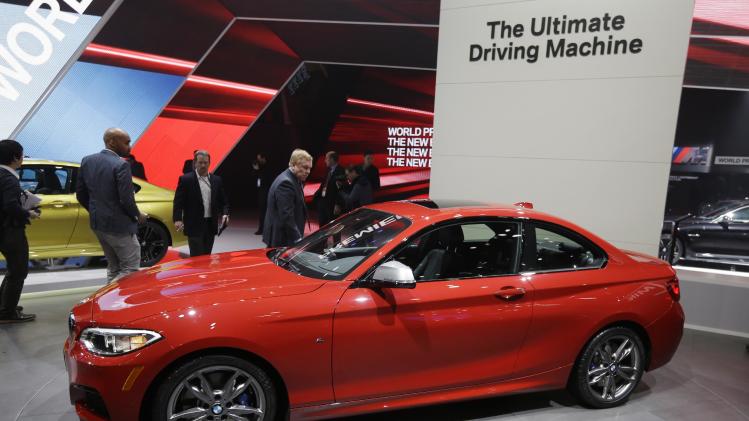
The agile, turbocharged, rear-wheel drive M235i is downright fun to drive and relatively affordable — for a BMW with turbocharged six-cylinder power.
This first M Performance Automobile (MPA) from BMW to arrive in the United States has variable sport steering and an adaptive suspension that can amaze in racetrack cornering, and yet they are comfortably mannered enough for daily commutes.
In fact, the M235i, which is the top of BMW's new 2-Series model line, is being compared by some to BMW's revered 2002tii from the 1970s. The compact, two-door 2002tii had authentic sports car chops and is known by fans as "the BMW we all loved." And the $40,000 price tag often found on the surviving 2002tii gems isn't far from the price for a 2014 M235i, which the federal government classifies as a subcompact.
Starting manufacturer's suggested retail price, including destination charge, for a base M235i with 320 horsepower from a twin-turbo six cylinder, is $44,050. Buyers choose between an eight-speed automatic and six-speed manual with no change in price on the M235i. The all-wheel drive version — the M235i xDrive — has a starting retail price of $45,850.
To be sure, there is an entry 2-Series model, the 228i Coupe, which has a starting MSRP with destination charge of $33,050. The 228i comes with 240-horsepower, twin-turbo four cylinder but does not have an "M'' in its name because it is not an MPA.
MPA is BMW's label to differentiate new cars that have some, but not all, the sporty characteristics and machinery that are in the pricey, high-performance M models.
In the United States, for example, the lowest starting retail price for a 2014 M model — the M3 Sedan with 425-horsepower M twin-turbo six cylinder — is $62,950.
Complicating the M story is the fact that BMW also offers an "M Line" option package on some of its cars. This package can include such things as M suspension calibration, M sport steering wheel, sport front seats and rear spoiler.
But, of course, there's no M Line option on the M235i, because this model already has these items and much more.
Standard M235i equipment includes an electronic locking function on the rear differential, M Sport Braking system, 18-inch, Michelin Pilot Super Sports tires, power moonroof, automatic climate control and Xenon headlights, among other things.
But the M235i doesn't have a specially developed M engine. The 3-liter, twin-scroll, turbocharged, direct injection six cylinder is used in other BMW vehicles, such as the 335i Sedan.
Competitors to the M235i are few, since coupes have been losing popularity among U.S. car buyers for decades. The 2014 Audi S5 Coupe with 333-horsepower, supercharged six cylinder has a starting retail price of $53,395. The 2014 Porsche Cayman with 275-horsepower, six-cylinder engine, starts at $53,595.
The 2-Series coupes are about the same exterior size as a Honda Civic Coupe. But they are longer and wider than the BMW 1-Series models that they replace. The 2-Series models also look more respectable as BMWs in size and in their use of materials. The M235i, for instance, wears a front apron and door sill strips with aluminum inserts printed with M235i
Inside, the sport seats are leather, not BMW's SensaTec, and interior plastic has an upscale appearance. But, the display screen jutting out of the top of the dashboard looks like an add-on. And the automatic gear shifter takes some getting used to.
The test M235i was low enough that passengers and driver dropped down onto the seats as they entered, and they had to lift themselves to get out. Back-seat room is scarcely better than it was in the 1-Series. There's just 33 inches of legroom back there. Passenger views out of the car can be obscured by taller vehicles.
This car could scoot, though, so it didn't have to stay long behind or next to lumbering sport utility vehicles and pickups.
The ready acceleration, in fact, was a highlight of the M235i. In regular driving, it wasn't a brawny surge of power that came on, but strong, steady propulsion that could still push driver and passenger backs into the seatbacks.
Plus, a Launch Control function amps that up by maximizing traction and adjusting engine performance — so much so that BMW achieved 0-to-60 miles per hour in just 4.8 seconds, which is sports car territory.
For the record, peak torque is 330 foot-pounds, coming on as low as 1,300 rpm and available to 4,500 rpm, so getting extra power at a moment's notice is not difficult.
Still, the M235i isn't a lightweight. With that six-cylinder engine up front, the car weighs 3,535 pounds, and the 52 percent to 48 percent front-to-rear weight balance gives a nod to the heavy front.
But the car's low center of gravity, wide track and masterfully engineered suspension are a wonder at keeping the vehicle on even keel in various driving maneuvers. The tester felt unfettered going through a slalom and easily carved up twisty mountain roads.
Yes, there is an Eco Pro setting that changes engine mapping to maximize fuel efficiency.
And every 2-Series includes Auto Stop-Start, which automatically turns off the engine when the car is stopped and idling, say, at a traffic light. It starts up again on its own when brake pedal pressure is lessened.
Fuel economy with the automatic garnered the best federal government rating at 22 miles per gallon in city driving and 32 mpg on the highway. The tester averaged 23 mpg.


No comments:
Post a Comment